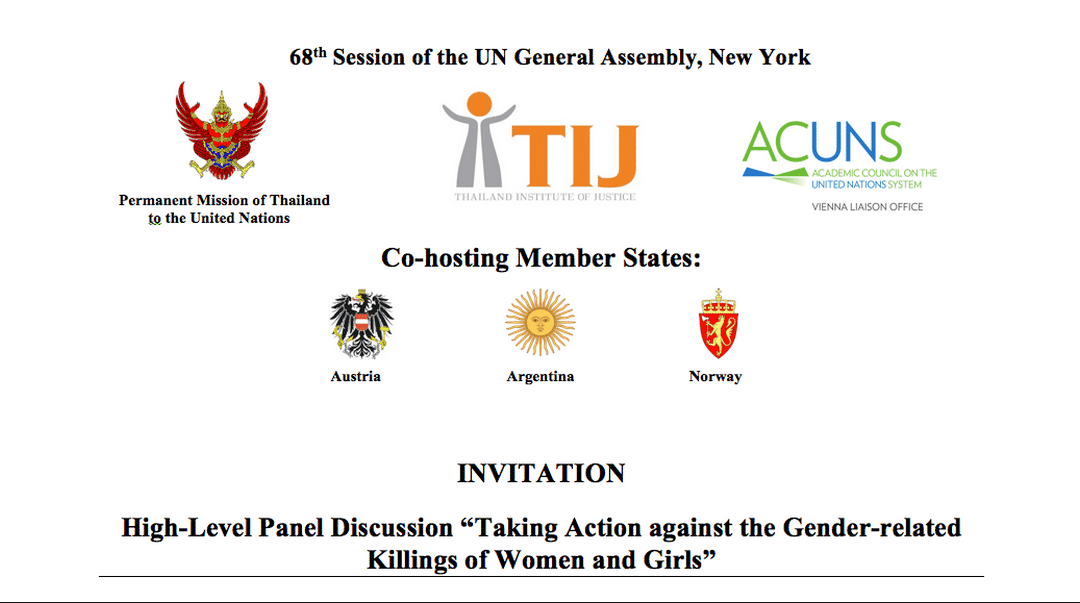


Council of Europe Convention: A roadmap to interpret the solutions to violence
by Anna Costanza Baldry, PhD The Council of Europe Convention entered into force on August 1st, 2014. One might think that women will be less at risk of suffering violence, those who are already victims will be more protected, Justice will be quicker in having to do with these cases and more certain, children more aware of the risks that undermine in misogynous and odd relationships and who abuses, the stalkers and rapists finally change register, they will help and will stop to rape and kill women. But gender-based violence isn’t a fairy tale, for centuries exists and persists. It was never cleared with the entry into force of a rule, or by introducing only partly effective policy with counter-action and prevention, although prudent from international organizations. An evidence is that if in 2014 still we need a Convention that’s so well articulated to remind us what and how many areas on which operate for a true structural change in contrast to gender-based violence, this means that even if the road is built, still must be traveled (Baldry, 2014). To date, has Italy all the cards in good standing, is ready? Last year ratified the Convention, has hastily put together rules on so-called femicide (Law 119/2013) in order to respond to some of the articles ratified in the Convention, putting in a broader Decree-Law 93/13 containing rules on the protection of order and public security, Civil Protection and for the extension of the compulsory administration of provinces. Sure, has respected what is required in some of the articles ratified in the Convention, on the other has yet to engage:...
Strengthening Understanding of Femicide
Violence against women has received increasing international attentionas a public health and human rights concern. However, femicide, one ofits extreme manifestations, is still not well understood. While a number of studies have been conducted, mainly in high-resource areas, reliable and globally comparable data on its nature and prevalence remain scarce Femicide has been addressed in different contexts, including intimatepartner violence, stranger violence, rape and other sexual violence, and honor and dowry practices, as well as murders associated with gang activity and political violence. A number of definitions have been proposed by researchers and activists, leading to methodological differences in the collection and interpretation of data In addition, a range of methodologies has been used in different contexts to collect data on femicide, including population-based studies; analysis of service records; homicide, police, hospital, court, and mortuary statistics; domestic fatality reviews; verbal autopsies; and review of newspaper articles. Each methodology has advantages and disadvantages with respect to the ease with which data can be collected, the rigor of the data, and the use of data in advocacy efforts In April 2008, PATH convened a first-of-its-kind conference on femicide, frequently referred to as “the gender-based murder of women” or “the murder of women because they are women.” The conference, “Strengthening Understanding of Femicide,” was co-sponsored by the Latin American Alliance for Gender-based Violence Prevention and Health (InterCambios), the South African Medical Research Council, and the World Health Organization. It brought together activists, researchers, and forensic professionals from Canada, Chile, Costa Rica, the Dominican Republic, England, Guatemala, India, Jamaica, Jordan, Mexico, Nicaragua, South Africa, and the United States, who collectively represent the most...
Femicide and the Palestinian Criminal Justice System
by Nadera Shalhoub-Kevorkian Despite the criminalization of abuses inflicted upon women, laws are still considered major sources of women’s oppression. This article discusses how Palestinian society and its criminal justice system, during a politically formative period of state building, relates to “femicide,” Femicide in this study pertains to the murder of girls or women for allegedly committing “crimes of family honor.” Official statistics, Cassation Court rulings, and six documented cases were analyzed in depth to determine the role played by the penal code, the legal system, and the external sociocultural context in exonerating the perpetrator of femicide and placing the placing placing the victim on trial. The data reflects a silent masculine conspiracy that empower sexist and gender-biased legal policies. The article concludes by challenging Palestinian legislators to fight legal discrimination against women. It argues that state-building periods can be a “window of hope,” offering societies such as Palestine’s the unique opportunity to reexamine and reconstruct their laws from a gender-sensitive position. Femicide and the Palestinian...
Female-Perpetrated Femicide and Attempted Femicide: A Case Study
Femicide, the homicide of women, is the seventh leading cause of premature death for women overall. Intimate partner (IP) homicide accounts for approximately 40% to 50% of U.S. femicides. The vast majority of IP femicides are perpetrated by male partners, with .05% of IP femicides in the U.S. perpetrated by female partners. Few studies have examined intimate partner violence (IPV) between female partners and no study (to the authors’ knowledge) has examined female-perpetrated IP femicide and attempted femicide in same-sex relationships. This case study examines IP femicide and attempted femicide among a small sample of women in same-sex relationships. The findings call attention to this important women’s health issue, expand our contextual understanding of violence in female same-sex relationships, and assist health care, law enforcement, judiciary, service, and advocacy professionals to develop prevention strategies and resources to reduce the risk of serious injury and death among women in same-sex relationships. Female-Perpetrated Femicide and Attempted Femicide A Case...
Female Versus Male Perpetrated Femicide
An Exploratory Analysis of Whether Offender Gender Matters Femicide, the murder of females (most often at the hands of males), is an understudied area in homicide research. Furthermore, femicide perpetrated by females has been all but ignored. One reason this may be is because of the rarity of homicide victimization perpetrated by females. Rather, most homicide incidents consist of a male offender and a male victim. When a homicide does involve a female, either as a victim or as an offender, the other party implicated is generally a male. The primary goal of the proposed study is to provide an in-depth, albeit exploratory, examination of female-perpetrated femicide. Using homicide data taken from the Dallas Homicide Unit, 403 cases of femicide will be analyzed, with special attention devoted to comparing female-perpetrated femicide incidents (n = 39) against male-perpetrated femicide incidents (n = 364). Specifically, the current study will explore the similarities and differences in sociodemographic characteristics of victims and suspects, offense characteristics, and offense circumstances. Contrary to what was expected, results, at first glance, seem to suggest an overwhelming similarity between femicide suspects and victims, irrespective of gender. However, when the relationship between victim and suspect is considered, distinct differences appear. Implications from these findings as well as limitations and suggestions for further research are discussed. Female Versus Male Perpetrated...
Combating Impunity and Femicide in Ciudad Juárez
By Lourdes Godínez Leal OVER THE PAST 15 YEARS, SOME 400 women have been murdered, and hundreds more have disappeared in Ciudad Juárez, the Mexican city that borders El Paso. The victims, most of them teenagers, have typically been abducted, raped, strangled, and left in empty city lots, often on their way home from work. Although the authorities have arrested and convicted a number of perpetrators—by the end of 2006 at least 160 were serving prison sentences—the killings have continued at the same pace. To date, law enforcement has not seriously investigated the serial nature of the killings, and the motivation for them remains a mystery. These crimes, together with official indifference, have given rise to a new term in Mexico: femicide, the systematic murder of women. Neither the end of the PAN’s political dominance in the state of Chihuahua in 1998 nor the end of the PRl’s decades of autocratic rule at the federal level in 2000 have had any effect on the official indifference to the killings. The impunity for violence against women that has prevailed for so long in Chihuahua has been maintained by officials of various parties. Even though the state attorney general’s office recently acknowledged that at least 364 women were murdered in the city between 1993 and 2005—and research has shown that this kind of anti-woman violence occurs elsewhere in the country—the problem of femicide has never taken its rightful place as a national electoral issue. Throughout the 1990s, Juárez was Mexico’s fastest-growing center of industrial production. Combating impunity and femicide in Ciudad Juarez...
Femicide & Femicide in Europe
GENDER-MOTIVATED KILLINGS OF WOMEN AS A RESULT OF INTIMATE PARTNER VIOLENCE. INTRODUCTION 1. This paper is prepared for the United Nations (UN) Expert Group Meeting on gendermotivated killings, taking place on 12 October 2011, in New York, U.S.A. The Meeting is organized by the UN Special Rapporteur on Violence against Women (VAW), its causes and consequences, Ms. Rashida Manjoo, and is intended to (i) build upon national, regional and international expertise on the manifestations, root causes and consequences of femicide; (ii) discuss policy, legal and institutional challenges at both national and regional levels with a view to address manifestations of femicide; (iii) identify good practices and lessons learnt in different regions. 2. This paper includes: (i) information about the use of the concept of femicide/feminicide in the European Union (EU) and its Member States; (ii) information on data collection about gender-motivated killing of women and rates of femicide/feminicide in EU countries; (iii) information on manifestation of gender-based killing in Europe; (iv) an overview of national legislative frameworks; (v) exposition of States’ responses to gender-based killings of women in terms of their due diligence obligation to prevent, protect, investigate and punish and provide reparations to women victims of such violence; (vi) case law on gender-based killings of the European Court of Human Rights and the UN Committee on the Elimination of all forms of Discrimination against Women (CEDAW); (vii) conclusion and challenges. Download the complete pdf here: SPINELLI B_EXPERT...
A Tale of Two Cultures
Intimate Femicide, Cultural Defences, and the Law of Provocation by Caroline Dick The prospect of raising cultural arguments in criminal cases has drawn criticism from a diverse group of scholars. While many feminists argue that the greatest danger of using culture in the courtroom is that it will result in judicial outcomes that put “race before gender,” critical race scholars maintain that minority cultural communities will be victimized by the colonial discourses that are certain to emerge when courts engage with cultural arguments. Liberal critics, on the other hand, argue that the move violates the principle of equal treatment before the law by providing cultural defences to some citizens but not to others and succumbing to cultural relativism. This article tests these hypotheses by examining the small, but important, body of case law where cultural arguments were raised in sexual provocation cases where the claimed provocative act was a woman’s infidelity or romantic rejection. This jurisprudence is an apt candidate for testing the competing propositions both because provocation is a gendered defence and because recent changes to the law have opened up space for cultural argumentation. The results of this examination are mixed. The liberal contention that refusing to take the culture of the accused into account will result in the equal application of the law is not borne out, nor is the feminist contention that introducing culture into the courtroom will place race before gender. Instead, the Canadian jurisprudence is better represented by a different ordering principle—that of colonialism before patriarchy. Download the entire pdf here: A tale of two cultures – Intimate Femicide, culturale...


